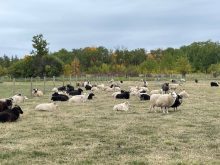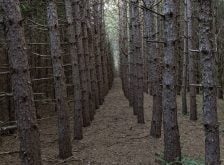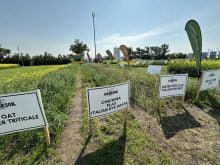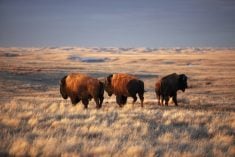Cover crops have been much heralded as possible wonder fits for Canadian Prairie cropping systems. Sometimes they might fit. It really depends heavily on our most important nutrient of all — water — and the type of following crop you intend to grow.
In many years of Prairie crop evaluations, it is no surprise that on the southern Prairies, crops such as wheat, barley, peas and canola can mature by the end of August for harvest in September. As we move north, crops are slower to mature and are often harvested at mid- to late October and even later.
Read Also

Claas brings 1000 Series SP forage harvesters to Canada
In mid-August, Claas unveiled its new line of Jaguar forage harvesters at an event in Visalia, California, deep in the heart of that state’s dairy region.
Despite early-maturing crops on the southern Prairies, the big hurdle for seeding a cover crop in late August or September is usually a lack of soil moisture. On the other hand, northern growers, harvesting late, end up with no time for the cover crops to grow to any extent, despite good soil moisture levels, before the October frosts and November snows halt plant growth.
Crops such as corn and soybeans are out for following cover crops because, Prairie-wide, they are late to very late maturing whether for grain or silage.
Should we call cover crops on the Prairies catch crops as they do in the United Kingdom? In that country and much of Europe, it is common practice to remove most small grain crops such as canola (rapeseed), wheat, peas, barley and oats in August to September, usually leaving the cropland with good moisture and up to three months of growing conditions left in the season due to the much milder climate. This kind of situation occurs in the United States in the central and northeastern states and even southern Ontario.
Realistically, for much of the Canadian Prairies, we will be looking at opportunistic catch crops rather than the vaunted mixed cover crops.
As far as Western Canada is concerned, I have seen quite successful catch/cover crops in Alberta and in other parts of the Prairies.
Pea crops
I have seen pea crops combined in some years by the end of August or early September. What the smart farmer then does is heavy harrow the pea stubble and bury a few bushels per acre of peas that missed the combine. Under moist soil conditions, these peas will germinate and, in most instances, grow well into the end of October.
What the farmer has done is to avoid fattening up the area’s goose populations, saved the spilled peas that will have now grown a foot or so and undoubtedly nodulated and fixed perhaps 10 to 20 pounds of nitrogen per acre. The overwintering dead pea crop also acts as a good snow trap and the dead pea stems are water conductors into the subsoil. I would call this a good “catch crop.”
Following early-harvested small grain cereals, canola or peas, you could consider winter wheat, fall rye or triticale. Now the dilemma. In the southern Prairies in “wet weather” cycles, the rye, wheat or triticale could be considered as a catch crop and grazed or killed in late May, to be followed by late-seeded crops such as dry beans, soybeans or corn. On the other hand, if it turns out to be a very dry spring, it may be worth letting the fall-seeded crops grow on to maturity.
Very wet springs
In very wet spring weather conditions, which occur from time to time, seeded crops can be drowned or field conditions are too wet to seed well into late May or even into June. Under such conditions, it would be wise to seed with oats or barley as soon as you can get on the land.
The late-seeded crop can be taken off as greenfeed, cultivated under or chemically fallowed. This would be a “catch crop.” You have also saved a percentage of the nitrogen that could have diminished or vanished in the wet soil. You have also improved soil friability, lost lots of excess moisture via the grain crop and improved future soil water penetration.
Cover crop agronomy
What are two of the most destructive soil-borne diseases presently common on Prairie cropland? These diseases are clubroot of canola and aphanomyces root rot of peas. What are you being offered as cover crop species? Radish and turnip are both members of the crucifer family, and to the best of my knowledge both susceptible to clubroot.
In this cover crop mix you may also have shepherd’s purse, stinkweed and volunteer canola establish and grow in the cover crop mix. All of these are clubroot hosts. Planting these on clubroot-infested cropland would be like throwing kerosine on a campfire. Again, peas, clovers and vetches are all members of the pea family and may well be susceptible to aphanomyces. If you are growing long-term rotations to control pea root rot, why would you use peas or other legumes in a “cover crop” mix?
Red clover
Cover crops are projected as interesting possibilities in Prairie crop production; however, in reality, they are best left alone for areas with long “vacant” growing time periods between crops. This vacant space on the Prairies is either very limited or non-existent. In addition, cover crops could remove valuable water reserves in dry growing cycles on the Prairies, and even if they did establish well in a warm fall, they could remove inches of valuable water needed for spring crops.
Potato growers I have noted Prairie-wide growing dryland seed or maincrop potatoes always acquire suitable cropland a year in advance, which they chem fallow to build up soil moisture reserves for the following year’s potato crop. Under this regime, it’s not uncommon for dryland potatoes to yield 15 to 20 tons per acre. In case you may not know, both Alberta and Manitoba each grow more tonnage of potatoes than the former leader, Prince Edward Island.
One possible suggestion that was given to me by a farmer was to apply “cover crop” red clover seed to a canola crop being sprayed for sclerotinia. Red clover seed could germinate under an opening canola canopy. After the clover seed germinates, the fallen canola leaves and flower petals would allow light to penetrate to the soil surface allowing the seedlings to grow. This red clover seeding would be around mid-July allowing the red clover two to three months of growth during canola crop maturation and after removal of the canola crop in September.
On the positive side, recommended species such as hairy vetch (Vicia villosa) can be hard to establish, but it’s winter hardy and a very good nitrogen fixer. On the negative side, if you are an annual crop grower, hairy vetch is tolerant to both glyphosate and glyphosinate and, therefore, you need phenoxy or other herbicides to eliminate this legume. Its long-lived, hard seed may allow it to become a nuisance weed in some instances.
















